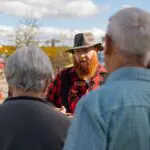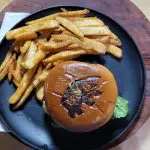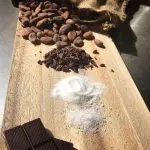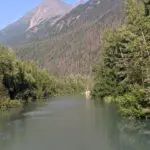1. Wasilla, Alaska’s Wal-Mart sells more duct tape than any other Wal-Mart store in the world.
The city of Wasilla, Alaska, was named “Honorary Duct Tape Capital of the World ” in 2002 by the Duck products company that makes duct tape of the same name. This title was gained after the local Wasilla Walmart outsold all other Walmarts nationwide. We’ve seen everything from suits fr prom made from it to people fixing planes and automobiles. Alaskan’s use it for everything.
2. The salmon shark is a close cousin of the great white. They frequent Alaskan waters and is one of the most formidable ocean predators here.
Weighing in at over 660 pounds with a growth of up to 10 feet, Salmon sharks have a wide tail with a double keel, which is unusual among sharks, but makes them very strong swimmers. Their quintessential shark features, long sharp teeth and long face with seemingly black menacing eyes, make them appear especially intimidating. Salmon sharks are highly migratory but frequent waters in the Gulf of Alaska, and in particular Prince William Sound (a smaller body of water connected to the ocean), which is a Pacific salmon fish spawning ground. These apex predators feed on salmon, squid, sablefish, herring, walleye pollock, and a variety of other fish, as well as sea otters and marine birds. In Alaska, some fisheries consider the Salmon shark a pest as they are thought to consume from 12% to 25% of valuable salmon each year.
3. Alaska is among the most coffee-obsessed states in the nation.
Popular opinion has it that Alaska’s climate contributes to the city’s obsession with drinking coffee; that would be to warm up and get energized on those cold and dark winter days that stretch out for almost half a year in the state. But in reality, it’s the numerous quality coffee shops, exclusive to the state and the sense of community that sharing a hot cup of Joe gives people. Alaska’s coffee culture even rivals that of Seattle, known as the Coffee Capital of the world, and was the origin state of the global coffee giant Starbucks. Heritage Coffee Roasting Company has been one of Alaska’s prime coffee pioneers since the early 1970s. Their products are served in over a hundred hotels, restaurants, and coffee shops across the state.
4. The most Northern, Eastern, and Western points in the United States of America are located in Alaska.
By simply looking at a world map and zooming in on the United States, you can see that Alaska has the northernmost and westernmost points. But did you know it’s also the state with the easternmost point? Take a closer look, and you can observe the Aleutian Islands crossing the 180-degree meridian of longitude. This places some of the islands in the Eastern hemisphere hence why Alaska takes the prize for most northern, eastern, and western points in the US.
5. Many Alaskan tour guides will tell you we eat more ice cream per capita than any other state in the union. This is false.
Contrary to what online resources indicate, Alaska is not the state that consumes the most ice cream per capita. It is true that ice cream here is indeed very popular, and it’s common to find artisanal ice cream parlors across the state. Alaska even has its very own native version of ice cream, from thousands of years ago, known as Akutaq (see Curious Fact number 7). However, the state that eats more ice cream per capita, according to online resources, is the District of Columbia, and the sole city that consumes most is Long Beach California. Nonetheless, we Alaskans are deeply fond of the cool creamy dessert, and we love to have it all year round, whether winter or summer.
6. We are the only state in the union that has three types of North American bears. Polar, brown, and black bears all call Alaska home.
Alaska’s diverse lands and natural resources make it possible for many animal and plant species to thrive in the state. So it is no surprise that the brown bear, black bear, and the polar bear all inhabit this chilly North American region. In fact, around 98% of the U.S. brown bear population lives in Alaska. Bears are intelligent and curious carnivorous mammals and, in most cases, are not seen as a big threat as they tend to ignore humans, but naturally, they deserve our respect, and a safe distance should be kept when near one. For the best tips on how to enjoy a safe bear sighting in “Bear Country”, click here and check out information provided by the Alaska Department of Fish & Game.
7. Akutaq (a-goo-duk) is a Yupik word that means to mix them together. It is the Yupik version of ice cream, who have been making it for thousands of years in Alaska.
Though it has no real similarity with the commercial ice cream we buy in grocery stores nowadays, Akutaq is a dessert that has been made by Alaskan natives for thousands of years. It is still a common delicacy to this day. Way back when, the indigenous Yupiks of Alaska thrived on Akutaq for survival, and it was typically carried by hunters for nourishment during their long travels. This Alaskan fare, also referred to as Eskimo ice cream, is made primarily from animal fat or tallow, and meat from fish or alternatively dried moose. The only similarity that it has to modern ice cream is the addition of berries, which are used to sweeten the Akutaq. The ingredients are mixed until light and fluffy, at which point the creation has a slightly closer resemblance to the frozen dessert we eat today.
8. Many people think the most deadly animal to humans in Alaska is bears. That is incorrect, it’s dogs.
You may find sources that list The Alaskan malamutes as one of the most dangerous dog breeds to exist. And though they are bred as heavy sledding and hunting dogs, they don’t have a reputation for attacking humans. As with most dog breeds, their behavior can depend a lot on how they are brought up from a young age, so training them is essential, more so when having them in a family home setting with other, smaller pets present. The Alaskan malamutes have a high prey drive and are known for having the capability of hunting animals as large as polar bears. Cute as they are, these fur balls are known to show aggressive traits when they feel danger or a threat, as their natural instinct is to protect themselves.
9. The last shots fired in the American Civil War were in the Bering Sea off the shores of Alaska by the C.S.S. Shenandoah.
While many remember the initiation of what is considered America’s most deadly conflict, few think about the day and location where the last shots were fired. Though the Civil War officially ended on April 9th, 1865, it is believed that the last shots were fired over a month after that, on June 22nd, 1865, in the Bering Sea. A plank was fired at a New Bedford whaling ship, which, unrelated to the war itself, in a sense, saved the gray whales that were being hunted. Records indicate that the shooter was British-born gunner John L. Guy.
The C.S.S. Shenandoah, a warship constructed in Glasgow, Scotland, was the only ship in the southern navy to circumnavigate the globe. James Bulloch, a Confederate agent in Europe, acquired the vessel by orders of the Confederacy’s naval secretary Stephen Mallory. The ship’s battle flag is preserved at the Museum of the Confederacy in Richmond, Virginia. Read more about the C.S.S. Shenandoah’s history here.
10. If you are a single lady looking for a man in the last frontier, the odds are good but the goods are odd.
Alaska is one of the few states with a higher male-to-female population ratio. How ever did this come to be? It has occurred to us that perhaps the old-fashioned cliche of outdoor, tough and rugged manual labor, such as mining, fishing and hunting, that attracts more men than women to the state. The outdoor lifestyle is certainly a huge part of life for Alaskans. We wouldn’t say that Alaskan men are fussy fellas, but most of them are certainly set in their ways. If coincidentally you have your eyes set on an Alaskan male, read these “commandments” and get a better understanding of how to go about conquering your very own stud in the Last Frontier. Rumor has it, chances of success are high.
Join us here at Alaskan Footprints and have our expert local guides tell you about other quirky facts while you enjoy a Food Trek in the wildly beautiful Anchorage area.







